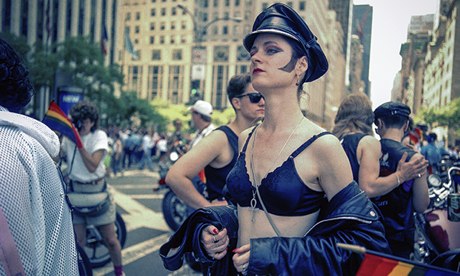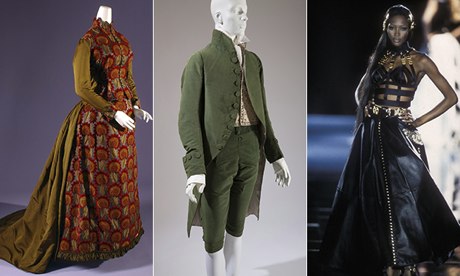
'The exhibition explores gay people as both designers and trendsetters.' Photograph: Joyce Culver
The celebrity-heavy unveiling of New York's annual Met Ball may guarantee its home, the Costume Institute, a certain amount of attention each year, but it is not the only museum in the city that explores the history of fashion.
At the Fashion Institute of Technology, museum director and chief curator Valerie Steele has been carving out a reputation for shows that flirt with the fetishistic and expose the often uncovered side of fashion. Her latest, A Queer History of Fashion: From the Closet to the Catwalk, co-curated with Fred Dennis, delves into the LGBTQ contribution to style, from 18th-century London, where "mollies" cross-dressed (here in red velvet capes) and had mock marriages, to present-day America, where gay people can legally marry.
Steele says: "We wanted to put gay people back into history, not just by saying that some designers happened to be gay, but by saying, 'actually, LGBTQ people have had a big impact on fashion for a long time, and it's not just by chance.'". Ranging from the sober to the flamboyant, and referencing hanky codes, Aids awareness, leather and lumberjack, the exhibition explores gay people as both designers and trendsetters, through high fashion, street style and performance gear.
 An 1882 day dress. A man’s three piece silk velvet suit, 1790-1800, France. Naomi Campbell models Versace, leather evening dress, autumn/winter 1992
An 1882 day dress. A man’s three piece silk velvet suit, 1790-1800, France. Naomi Campbell models Versace, leather evening dress, autumn/winter 1992 While many designers these days are openly gay, homosexuality in the industry was once either a fiercely guarded or an open secret. Dior was terrified his mother – and the wider world – would find out he was gay; Yves Saint Laurent's relationship with Pierre Bergé was only explicitly romantic later in his career; and Austrian designer Rudi Gernreich (if only we were all floating about in his printed unisex kaftans) was a founding member of gay rights group The Mattachine Society in 1950 - although he quickly quit, terrified he would be arrested and deported from the US.
The show is a small, celebratory sprint through centuries of style. Certain looks stand out: the lesbian elegance of the 1920s, typified by the Monocle club; Marlene Dietrich's looks, which show off her impeccable taste as well as her gender-bending; the moving collection of Aids awareness T-shirts; Versace's leather ballgown, which disgusted wealthy women in Dallas early in his career, but captured the fashion world's imagination during his heyday 15 years later ("Now look: 200 socialites in bondage!" he laughed, according to Steele).
There is great pleasure in imagining the people connected to the clothes, too. A Saint Laurent suit isn't just a great example of the designer's tailoring, but was also worn by Aids activist Larry Kramer. Spanish designer Miguel Adrover's astonishing – but kinda gross – coat is made out of Quentin Crisp's stained old mattress, which he found in the rubbish after the raconteur's death.
Since the exhibition ends with the plain suits worn by a male couple at their recent marriage, the question is: will greater assimilation make LGBTQ fashion less "queer"? Steele thinks not. "People have been saying that for years: 'We're not going to be so edgy! It'll be all bourgeois with gay marriage!' First of all, it's not all New York and London – there's Egpyt, Russia, Uganda, lots of places where there's still tremendous hostility towards gay people. Also, there's the sense of feeling different; that your gender or sex alignment is not the norm. I think that sense of being different is not going to disappear."
• A Queer History of Fashion: From the Closet to the Catwalk is at The Museum at FIT, New York , until 4 January 2014.
via fashion - Google News http://news.google.com/news/url?sa=t&fd=R&usg=AFQjCNE2RKcfzjqjpbzVaqV2ADinoe3SOw&url=http://www.theguardian.com/fashion/fashion-blog/2013/sep/25/queer-history-fashion-closet-catwalk-review




0 意見:
張貼留言